Did you know that the Marcos regime in the Philippines lasted for over two decades? This period marked one of the longest authoritarian rules in modern times. The political doctrine of the Marcos regime deeply affected how the country was governed.
Key Takeaways:
- The Marcos regime in the Philippines lasted for over two decades.
- The political ideology of the Marcos regime had a significant influence on the country’s political landscape.
- Understanding the political ideology of the Marcos regime is crucial to comprehending the governance and policies implemented during that time.
- Exploring the key principles and beliefs of the Marcos regime can provide insights into the lasting impact it had on the Philippines.
- Examining the ideological underpinnings of the Marcos regime helps in understanding the country’s history and shaping its future.
The Genesis of Marcos’s Political Narrative
Early Years and Military Service
Ferdinand Marcos, the former President of the Philippines, had a unique path to leadership. He was born on September 11, 1917, into a powerful political family in Sarrat, Ilocos Norte. His father was a congressman, and his mother a schoolteacher.
Marcos was a bright student from the start. He chose to study law at the University of the Philippines. There, he joined groups fighting for the rights of Filipinos. This period shaped his belief in working for the people’s well-being.
In World War II, Marcos fought against the Japanese to protect the Philippines. This experience made him eager to serve his country. It strengthened his will to stand up for his people’s rights.
Marcos’s heroism in the war was a central part of his image as a leader. People respected him greatly because of this. It helped him start his journey as a public servant, aiming for a prosperous, united Philippines.
Cultivating the Cult of Personality
Marcos was also known for building a powerful personal brand. He knew that looking strong and in control was key to keeping his rule. So, he made sure he appeared powerful and charismatic to his people.
To make his image even stronger, Marcos invested a lot in his public image. He organized grand events and painted himself as the country’s savior. By managing the media, he created an unbeatable image of himself as the nation’s ultimate leader.
Marcos once famously said, “I have no friends; I have only loyal servants.” This quote captures his belief that loyalty was everything in maintaining power.
By presenting himself as larger than life, Marcos kept a tight hold on the country’s politics.
The Stonehill Scandal and Political Fortification
The Stonehill Scandal was a turning point for Marcos. It started in 1962 when corruption charges hit Harry Stonehill, an American businessman. The case soon involved people close to President Macapagal’s government.
Marcos used the scandal to his advantage. He claimed to be the one who could fight corruption. This strategy made him appear as a standout choice for cleaning up the government.
Thus, through the Stonehill scandal, Marcos positioned himself as a reformer. He promised to fix the country’s problems. This story made him more appealing as a clean-handed leader.
The Stonehill scandal was key in the events that led to martial law. It gave Marcos a reason later on to take strict measures. His supporters believed only he could bring peace and order to the nation.
To wrap it up, Ferdinand Marcos’s leadership was marked by his early life, military role, his strong image, and the Stonehill scandal. These aspects were crucial to his leadership from the start and during his time as president.
Emergence of a New Political Order
Ferdinand Marcos used martial law to change the political scene in the Philippines. By doing this, he aimed to have more control and change how leadership worked. Marcos turned the president’s job into one more like a prime minister. This gave him even more power.
Consolidation of Power Through Martial Law
In 1972, Marcos began his control with martial law. This was a time of emergency that let him rule the country almost entirely. With Proclamation No. 1081, he could stop those who opposed him, limit what people could do, and make the rules himself.
Under martial law, Marcos could stop anyone who disagreed with him. He used the army, censorship, and threats to make sure no one spoke against him. People were scared to speak out.
Marcos said he needed martial law because the country was not safe inside. But, most people think he did it to hold onto power and stop anyone from challenging him. This way, he did not have anyone to stop his way of ruling.
Transforming the Presidency into a Prime Ministerial Role
As well as using martial law, Marcos changed the president’s powers. He shifted the job to be more like a prime minister. This gave him even more control and let him rule in ways presidents could not.
This move helped Marcos to get more powerful by taking power away from others in government. By doing so, he was able to rule almost completely without anyone else to stop him. He could decide on his own without needing approval from many others.
Martial law and making the president more like a prime minister were both key to Marcos’ government. They helped him to have a lot of power and keep control of the Philippines for a long time.
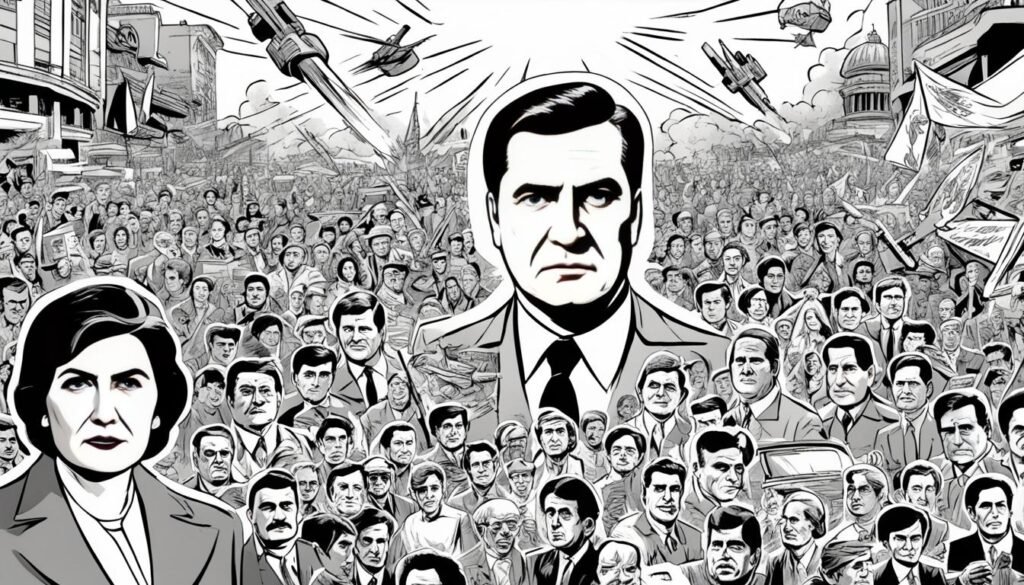
The evolution of political order was critical during the Marcos time. By using martial law and changing the president’s role, he could get a lot of power. This let Marcos rule with not many limits, making big changes in the Philippines while he was in charge.
Political Ideology During Marcos’s Presidency
During Ferdinand Marcos’s time as president, his political beliefs greatly influenced the Philippines. He led the country from 1965 to 1986 with a strong hand. His style was authoritarian and he followed specific principles and ideas.
Marcos strongly believed in a powerful central government. He placed great importance on the role of the president in making political decisions. This gave him full power over the country’s activities.
Another key part of Marcos’s thinking was his idea of constitutional authoritarianism. He thought the president should be able to limit civil rights and control the country when needed. His decision to declare martial law in 1972 showed his commitment to this.
When it came to the economy, Marcos focused on national growth and poverty reduction. His strategies, however, often led to crony capitalism. This meant that his friends got special treatment, becoming wealthy and powerful.
Marcos was also big on promoting Filipino culture and pride. He started projects like the “Bagong Lipunan” to boost national identity. The Philippines’ success in international sports was another way he showed off the country.
In all, Marcos’s time in office was defined by strict rule, centralized power, using the economy for personal gain, and a push for national pride. These ideas guided his leadership and marked the history of the Philippines.
The Ideological Underpinnings of Martial Law
To grasp why martial law was enforced under Marcos, we must look at its ideological roots. President Ferdinand Marcos signed Proclamation No. 1081 on September 21, 1972. This move stripped away civil rights, allowing for a crackdown on dissent and severe human rights violations.
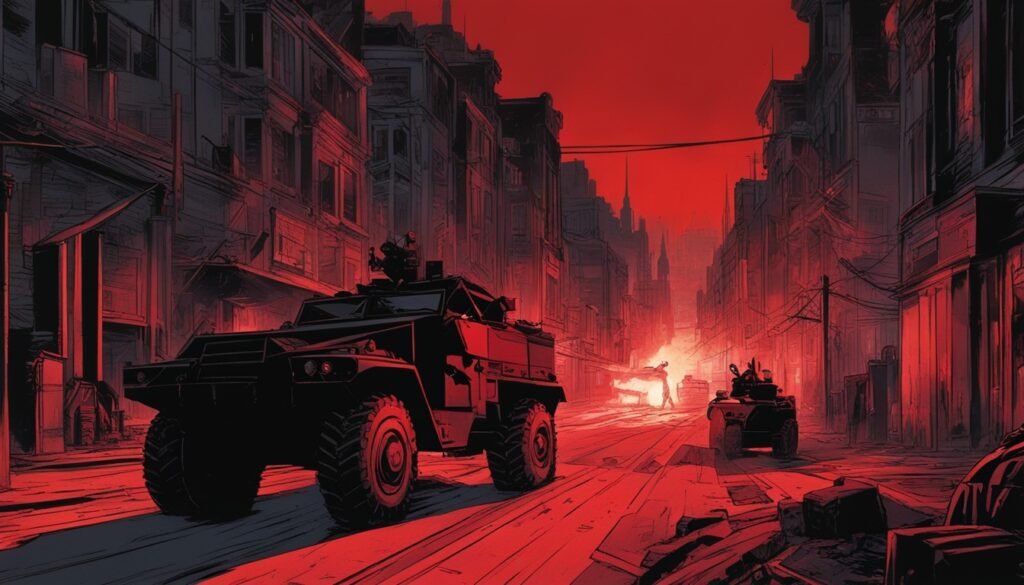
Proclamation No. 1081 and Its Implications
Through Proclamation No. 1081, President Marcos gained unchecked power. He aimed to protect national security, public order, and the rule of law. But, this led to heavy restrictions on freedoms, like suspending habeas corpus and controlling the media. Such actions concentrated power in Marcos’s hands, silencing those opposing him.
Suppression of Dissent and Human Rights Abuses
Under martial law, Marcos stamped out any opposition using brutal measures. His regime carried out illegal arrests, torture, and make people disappear. This affected not just politicians and activists but everyday citizens who disagreed with the rule.
These gross violations weakened the political situation and public trust in the government.
Contriving a New Society
Ferdinand Marcos aimed to create a new society in the Philippines during his rule. He called this new order “Bagong Lipunan,” or New Society. Marcos used a style of ruling called constitutional authoritarianism. It let him have a lot of power and control over the Philippines.
Marcos wanted a society without the flaws he saw in democracy. He put in place a new system of government under constitutional authoritarianism. This system gave the president the most power. It meant decisions were made centrally and quickly.
Marcos also made many economic policies and set up some monopolies. These moves were to make the economy stronger. But, they also made Marcos and his friends wealthier and more powerful. They controlled important parts of the economy.
The Coco Levy Fund scam was a big part of Marcos’s corruption. This scandal was about taking money meant for coconut farmers and using it wrongfully. The farmers didn’t receive the help they should have.
Marcos and his friends benefited a lot from this scam. They bought expensive coconut oil mills with the fund’s money. They profited while the farmers lost out. This was a clear example of how Marcos’s rule hurt the people.
This image shows how Marcos’s economic decisions and the Coco Levy Fund scam impacted Filipinos.
Looking at Marcos’s time in power shows how he wanted to change Filipino society. The idea of a new society, authoritarian rule, economic plans, the Coco Levy Fund scam, and more shaped his time as leader. These actions left a big mark on the Philippines.
Learn more about the Marcos regime and its impact on the Philippines.
The Role of Propaganda and Media Control
The Marcos regime in the Philippines was known for controlling information and the media. It used propaganda to influence what people thought and to support the government’s stories. By keeping the press under its thumb, the government tried to make sure the public saw things its way.
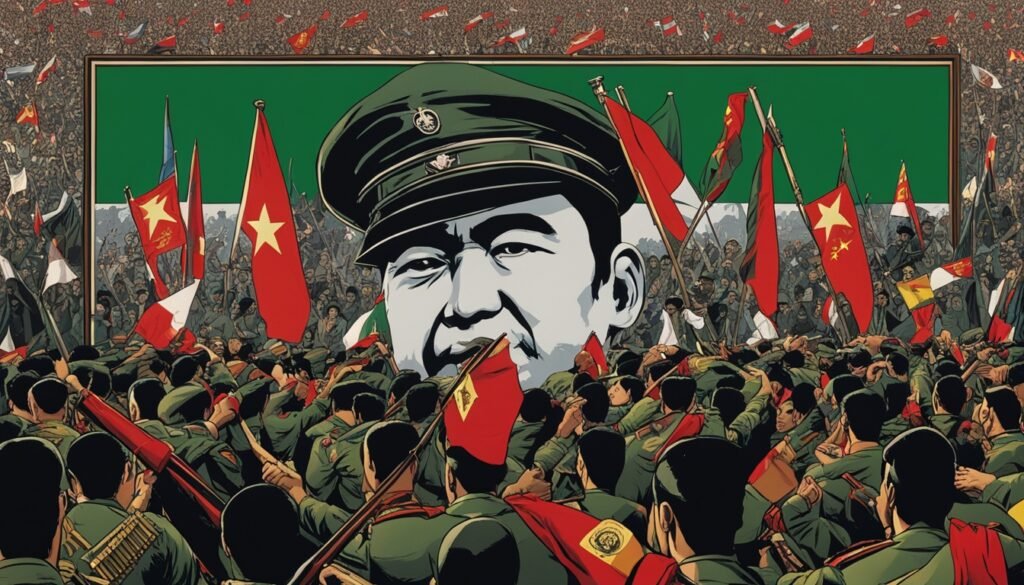
Muzzling the Press: Journalism Under Duress
During the Marcos years, the press had a tough time. There were many rules and censorship in place to stop any bad talk. Journalists were always watched and could even get into trouble if they wrote against what the government wanted.
The government made sure the media followed its messages. It forced media groups and reporters to push its ideas and goals. If anyone tried to do things differently, they faced trouble. This made sure the government kept tight control over the news.
State-Sanctioned Narratives
Under Marcos, a lot of effort went into making the government and its leaders seem great. They wanted people to think everything was going smoothly and everyone was happy. Any criticism was buried.
The regime focused on its successes to make it seem like everyone was pleased with them. They used media they controlled to spread this message. It helped them keep power, even though many in the Philippines were not happy.
The Marcos regime used many tactics to stay in control, like censorship and propaganda. These allowed the government to enforce its ideas and stay powerful. They often got away with doing many bad things because they controlled what news people saw.
Learn more about the role of propaganda in the Marcos regime here.
Economic Maneuvering and Crony Capitalism
During Marcos’s rule, the economy of the Philippines took a dark turn due to economic tricks and crony capitalism. Marcos and his friends used their power to control the economy, caring little about the people’s wellbeing. They put the needs of a few above those of the many.
They played a clever game with resources, focusing on making themselves and their friends rich. They took over industries, gave friends big government deals, and changed finance rules to add to their wealth. This way, they made sure they stayed powerful and rich.
The bond between big business and the government became very strong under Marcos. Those who supported him got ahead, creating a lot of unfairness. Marcos and his friends got really rich, leaving many Filipinos struggling.
“The economic policies implemented during the Marcos regime served as a means for Marcos and his associates to consolidate their control and enrich themselves at the expense of the Filipino people.” – Economist Jane Cruz
The impact of these activities was huge. The economy became controlled by a small group, making it hard for others to succeed. This made life tough for most Filipinos, limiting their chances to do better.
Also, the government ended up owing a lot of money. This debt is a problem that future generations of Filipinos will have to solve.
One example of the unfair actions under Marcos is the Coco Levy Fund scam. This fraud took money meant for coconut farmers and gave it to Cojuangco and his friends. It made the gap between rich and poor even wider.
The effects of what Marcos did are still being felt in the Philippines today. Overcoming these issues to create a fairer economy and society is a big task.
The Cultural Revolution: Gintong Alay and Other Initiatives
The Marcos regime started a cultural revolution in the Philippines. It was meant to boost Filipino culture, pride, and sports as ways to grow the nation. A highlight was the Gintong Alay (Golden Offering) program.
Gintong Alay asked Filipinos, especially the young, to use their talents for the country’s good. It covered areas like art, sports, learning, and helping communities. The aim was to make Filipinos proud of their country. It taught them how they could help it get better.
The Marcos government saw the value of sports for bringing people together and making friends with other nations. Hosting and joining sports events was a big part of their plan. This was a way to not only show off Filipino skill but also to make stronger ties with other lands.
The government made sure there were good sports venues and supported Filipino sports stars. They wanted the world to see how advanced the Philippines was. The international sports efforts were a sign of the government’s drive to improve the country and the lives of its people.
The 1981 Manila Southeast Asian Games was a key event. It showed the Philippines could match up in sports with others in the region. The image below catches the excitement of the time:
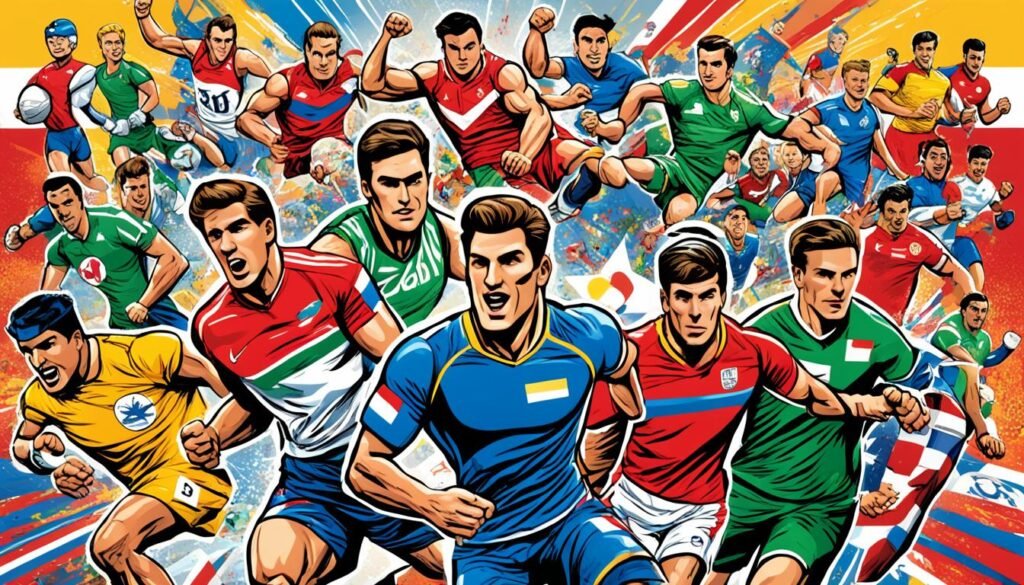
Deconstructing the Marcos Family Dynasty
To get what the Marcos regime was about, looking closely at the family’s power is key. Imelda Marcos, especially, shaped their political path in a big way.
Imelda Marcos’s Role in the Regime
Imelda Marcos, wife of Ferdinand Marcos, was not just quiet in her husband’s ruling. She was deeply involved in running the country, taking on powerful jobs.
She was Governor of Metro Manila, Minister of Human Settlements, and Ambassador to the UN. In these roles, she pushed for her goals and helped keep the Marcos family in control.
Her interests were beyond just politics. Imelda Marcos loved a luxurious life, buying lots of art, jewelry, and other expensive things. This showed the regime’s corruption and misuse of power.
The Children of Marcos: Political Heirs and Continuing Legacy
The Marcos family influence didn’t stop with Ferdinand and Imelda. Their kids have also joined politics, continuing their family’s impact.
Key figures among the kids are Imee Marcos, Irene Marcos-Araneta, and Ferdinand “Bongbong” Marcos Jr. They have tried to follow the family’s political path by running for public roles.
Imee Marcos has been Governor and now serves as a senator. Irene has kept a lower profile but takes part in cultural and charity work.
However, Ferdinand “Bongbong” Marcos Jr. is probably the most talked about. He ran for Vice President and is a big name in current politics, hoping to change how the Marcos regime is seen.
Their role in the Philippines’ politics today is a hot topic, making people think about the effects of the Marcos family dynasty.
Embedded Link: Read the Southeast Asia Working Paper on the Marcos Political Comeback in the Philippines
Unexplained Wealth and the Marcos Empire
Under Ferdinand Marcos, a huge amount of money appeared with no clear explanation. He and his group gained this wealth, leading to what people call the Marcos empire. We will look at how much wealth was collected and where it went. This story also questions if the Marcos’ wealth was gained in a legal way.
The Marcos team got a lot of money that we still aren’t sure about. People have said they took public money and used their power for personal reasons. These claims suggest the Marcos family got rich through unfair and illegal actions.
The Marcos empire included land in other countries. This land was investigated and fought over in court. It had expensive buildings, luxury homes, and other valuable things under different names or companies.
The Marcos’ also had secret assets, like art and jewelry. These things were hidden and only found after their time in power ended.
Whether the Marcos wealth was legally earned is still being discussed in courts. Attempts have been made to get back unfair money, within and outside the country. But proving where the money is from has been very hard.

We still don’t know everything about the Marcos empire. But, people are still digging and investigating. They aim to understand the money’s history, hidden assets, and the stories from offshore accounts.
Knowing about the Marcos empire is important for many reasons. It’s key to historical truth, holding the guilty ones responsible, and seeking justice for the Filipinos.
Explore further details about the Marcos regime and its impact on Philippine governance in this Foreign Affairs article.
The Political Ideology of Marcos’s Opposition
During the Marcos regime, many people opposed his strict rule. We will look at how they managed this. This will include the People Power Revolution and the fight against Marcos’s ideas.
The People Power Revolution Narrative
The People Power Revolution, or EDSA Revolution, changed the game in opposing Marcos. It was a peaceful, large-scale effort to remove Marcos and bring back democracy in the Philippines.
This revolution aimed for more political freedom, better human rights, and to stop Marcos’s harsh rule.
It’s a story about Filipinos joining up to push for political change in a peaceful way. Their unity, strength, and love for democracy stood out. The revolution became a global symbol of courage for those struggling against oppressors.
Counteracting Marcos Ideology: The Context of Resistance
The fight against Marcos’s beliefs involved many people. This included political groups, activists, and even regular citizens. They all worked together to battle Marcos’s way of ruling.
Their goal was to end authoritarianism, bring back democracy, and safeguard human rights. They wanted justice and fairness for all in the Philippines. Their joint actions were aimed at changing the stories the Marcos regime told and introducing ideas that put Filipinos first.
Their work was built on deep respect for democracy, free speech, and responsibility. They saw that Marcos’s way hurt many and created big social gaps and rights violations.
These efforts came with great danger. Many activists and leaders were silenced or suffered violence. But their refusal to give up led to Marcos’s end and the victory of democracy.
For deeper insights into Marcos’s opposition ideology, check out this source.
Post-Marcos Perception and the Fight Against Historical Distortion
The Marcos regime has left a lasting impact in the Philippines. It shapes how Filipinos today view their history. This view is influenced by memories, stories, and cultural factors. There’s an effort to fight against twisting historical facts about Marcos’ time.
Marcos-Related Legislation and Its Cultural Impact
Addressing historical distortions involves passing laws about the Marcos era. These laws help recognize the past’s wrongdoings and aim to bring justice to the victims. They also shape the collective memory of Filipinos and their understanding of that time.
For instance, the Human Rights Victims Reparation and Recognition Act of 2013 was created. It gives support and recognition to those who suffered human rights abuses under Marcos. This law helps honor their struggle and reminds us of the past’s injustices.
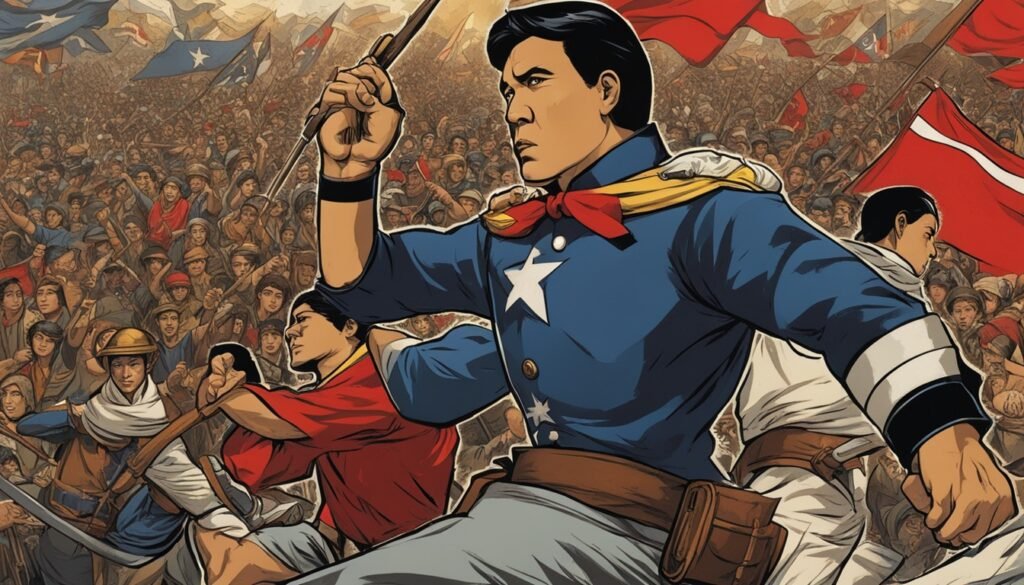
Moreover, building museums and memorials to remember the Marcos era is crucial. They’re places for people to talk, think, and learn. By keeping these stories alive, we prevent the past from being distorted.
Educational Initiatives to Correct Historical Narratives
Correcting our understanding of history starts with education. Recently, there’s been a push to teach a fuller story of the Marcos era. New lessons include the dictatorship’s impacts and the fight for democracy.
These topics give students a chance to think critically about the past. They learn to see the complexities of history. It helps them form their own views based on real facts and not myths.
Hearing from survivors and experts makes this learning richer. Their insights deepen the understanding of Marcos’ impact on the Philippines.
In the end, changing how we see the Marcos period combines learning from the past with today’s actions. Through legislation and education, we aim to heal old wounds. We also hope to build a just and knowledgeable society for the future.
Conclusion
The Marcos regime’s political views deeply affected the way the Philippines was run. We’ve looked at the main ideas that guided Ferdinand Marcos’s government. The Philippine Political Culture and Governance report offers insights into the political scene of that time.
Under Marcos, a new way of leading started with martial law. The presidency became more like a prime minister role. The Marcos government worked on new policies and projects. They aimed to build a “Bagong Lipunan” or New Society.
Yet, the Marcos era is also remembered for its human rights violations and not listening to opposite views. There were also questions around the wealth of the Marcos family. This kind of leadership sparked strong disagreement and the People Power Revolution. This revolution overthrew the Marcos family’s power.
Today, the Marcos legacy still influences the Philippines. It highlights the need for strong systems that keep leaders in check. Also, it shows the importance of respecting human rights and openness in government. Knowing about this part of Philippine history is key to a better future.
FAQ
What is the political ideology of the Marcos regime in the Philippines?
The Marcos regime was marked by authoritarian methods, martial law, and a new societal model called “Bagong Lipunan” (New Society). Ferdinand Marcos focused on his control, stopped any opposition, and made policies that helped his friends. This shaped the way he governed the Philippines.
How did Ferdinand Marcos shape his political ideology?
Ferdinand Marcos’s time in the military influenced his political beliefs. He built up his image, especially after the Stonehill scandal. This event claimed to show corruption, which helped Marcos push against the rich and powerful.
What role did martial law play in the Marcos regime?
Martial law was a key part of Marcos’s rule. He used Proclamation No. 1081 to limit freedom, stop protests, and abuse people’s rights. By doing this, Marcos strengthened his control, acting more like a prime minister, which let him lead for a longer time.
What were the core principles and beliefs that guided Marcos’s governance?
Marcos believed in being firm, fighting the powerful few, loving his country, and using the economy for his benefit. He tried to create a new Filipino way under “Bagong Lipunan.” He controlled the government firmly, and he wanted everyone to feel proud of being Filipino.
What were the main implications of martial law under the Marcos regime?
When martial law was declared with Proclamation No. 1081, freedoms in the Philippines suffered. Speaking against Marcos was hard, watching the news was limited, and many people were hurt. Arrests and even torture happened without a fair trial.
What were some of the key initiatives of the Marcos regime to contrive a new society?
The Marcos government tried to work differently by making strict rules and favoring some people in business. They also pushed for “Bagong Lipunan” to highlight what it means to be Filipino. But, their efforts to change things were sadly mixed with stealing public money, as seen in the Coco Levy Fund mess.
How did the Marcos regime control propaganda and the media?
Marcos silenced the press and put pressure on journalists. His government spread stories that helped his cause, making sure the news showed him in a good light. Those who spoke against him in media had a rough time.
How did Marcos and his close associates manipulate the economy during his regime?
The Marcos group played favorites in business, letting his friends get ahead. They found ways to get rich while many Filipinos faced hard times. Corruption was everywhere in how they handled the economy.
What were some of the cultural initiatives implemented by the Marcos regime?
Under Marcos, the Philippines worked to show the world its talent and unique culture. They used sports to show off but also to get more people to like the government. This was all to try and boost national pride.
What was the role of Imelda Marcos within the regime?
Imelda Marcos played a big part in the government, especially with spreading the New Society idea. Her extravagant lifestyle and the big amount of wealth she built up became well-known. It represented a big problem with how the government acted.
What was the extent of the wealth amassed by the Marcos regime?
The Marcos family got very rich, owning a lot both in the country and abroad. People wonder and check the facts on how they made all that money. The amount of money they might have taken unfairly from the country is thought to be enormous.
How did the opposition counteract Marcos’s ideology during the People Power Revolution?
The people against Marcos offered another view during the People Power Revolution. They fought for freedom and wanted to stop Marcos’s harsh rules. They worked to bring back democracy and fair government.
How is the perception of the Marcos regime and its ideology viewed in the post-Marcos era?
After Marcos, people in the Philippines worked hard to keep the true story from being forgotten. They made laws and did things to teach people the real history. This way, they hope to remember the lessons of Marcos’s time and guide the country better in the future.

